Related Research Articles

Alberta is one of the thirteen provinces and territories of Canada. It is part of Western Canada and is one of the three prairie provinces. Alberta is bordered by British Columbia to the west, Saskatchewan to the east, the Northwest Territories (NWT) to the north, and the U.S. state of Montana to the south. It is one of the only two landlocked provinces in Canada. The eastern part of the province is occupied by the Great Plains, while the western part borders the Rocky Mountains. The province has a predominantly continental climate but experiences quick temperature changes due to air aridity. Seasonal temperature swings are less pronounced in western Alberta due to occasional chinook winds.

Edmonton is the capital city of the Canadian province of Alberta. Edmonton is on the North Saskatchewan River and is the centre of the Edmonton Metropolitan Region, which is surrounded by Alberta's central region. The city anchors the north end of what Statistics Canada defines as the "Calgary–Edmonton Corridor".
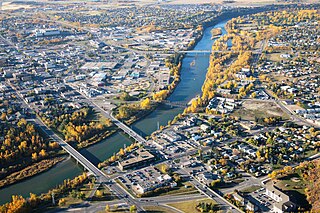
Red Deer is a city in central Alberta, Canada. It is located near the midpoint of the Calgary–Edmonton Corridor and is surrounded by Red Deer County. With a recorded population of 100,418 in the Canada 2016 census, Red Deer became the third Alberta city to surpass 100,000 people. The city is located in aspen parkland, a region of rolling hills that is home to oil, grain, and cattle production. It is a centre for oil and agriculture distribution, and the surrounding region is a major centre for petrochemical production.

Nicholas Roerich, also known also as Nikolai Konstantinovich Rerikh, was a Russian painter, writer, archaeologist, theosophist, philosopher, and public figure. In his youth was influenced by Russian Symbolism, a movement in Russian society centered on the spiritual. He was interested in hypnosis and other spiritual practices and his paintings are said to have hypnotic expression.

The University of Alberta, also known as U of A or UAlberta, is a public research university located in Edmonton, Alberta, Canada. It was founded in 1908 by Alexander Cameron Rutherford, the first premier of Alberta, and Henry Marshall Tory, the university's first president. It was enabled through the Post-secondary Learning Act.

Sherwood Park is a large hamlet in Alberta, Canada within Strathcona County that is recognized as an urban service area. It is located adjacent to the City of Edmonton's eastern boundary, generally south of Highway 16, west of Highway 21 and north of Highway 630. Other portions of Sherwood Park extend beyond Yellowhead Trail and Wye Road, while Anthony Henday Drive (Highway 216) separates Refinery Row to the west from the balance of the hamlet to the east.

Wetaskiwin is a city in the province of Alberta, Canada. The city is located 70 kilometres (43 mi) south of the provincial capital of Edmonton. The city name comes from the Cree word wītaskiwinihk, meaning "the hills where peace was made".

Douglas Joseph Cardinal is a Canadian architect based in Ottawa, Ontario. His flowing architecture marked with smooth curvilinear forms is influenced by his Aboriginal heritage as well as European Expressionist architecture. His passion for unconventional forms and appreciation of nature and landscape were present in his life from a very young age, and consequently developed into the unique architectural style he has employed throughout his career. Cardinal is perhaps best known for his designs of the Canadian Museum of History in Gatineau, Quebec (1989) and the National Museum of the American Indian in Washington, D.C. (1998). He is considered one of Canada's most influential contemporary Indigenous architects.
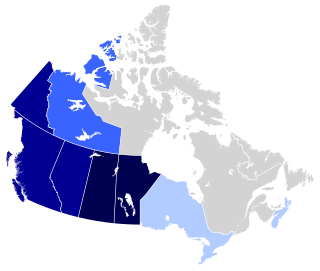
Ukrainian Canadians are Canadian citizens of Ukrainian descent or Ukrainian-born people who immigrated to Canada. In 2016, there were an estimated 1,359,655 persons of full or partial Ukrainian origin residing in Canada, making them Canada's eleventh largest ethnic group and giving Canada the world's third-largest Ukrainian population behind Ukraine itself and Russia. Self-identified Ukrainians are the plurality in several rural areas of Western Canada. According to the 2011 census, of the 1,251,170 who identified as Ukrainian, only 144,260 could speak the Ukrainian language.

Helena Ivanovna Roerich was a Russian theosophist, writer, and public figure. In the early 20th century, she created, in cooperation with the Teachers of the East, a philosophic teaching of Living Ethics. She was an organizer and participant of cultural activity in the U.S., conducted under the guidance of her husband, Nicholas Roerich. Along with her husband, she took part in expeditions of hard-to-reach and little-investigated regions of Central Asia. She was an Honorary President-Founder of the Institute of Himalayan Studies "Urusvati" in India and co-author of the idea of the International Treaty for Protection of Artistic and Scientific Institutions and Historical Monuments. She translated two volumes of the Secret Doctrine of H. P. Blavatsky, and also selected Mahatma's Letters, from English to Russian.
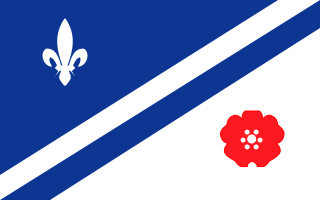
Franco-Albertans are francophone residents of the Canadian province of Alberta. Franco-Albertans may also refer to residents of Alberta with French Canadian ancestry, although publications from the government of Alberta use the term Franco-Albertan to refer to its francophone residents. In the 2016 Canadian Census, there were 86,705 Albertans that stated their mother tongue was French. In the same census, there were 411,315 Albertans that claim partial or full French ancestry.

Harcourt House Artist Run Centre is one of four artist-run centres in Edmonton, Alberta, Canada. The centre delivers a host of services to both artists and the community, and acts as an alternative site for the presentation, distribution and promotion of contemporary art.

Edmonton Public Schools is the largest public school division in Edmonton, the second largest in Alberta, and the sixth largest in Canada. The division offers a variety of alternative and special needs programs, and many are offered in multiple locations to improve accessibility for students. As a public system, Edmonton Public Schools accepts all students who meet age and residency requirements.
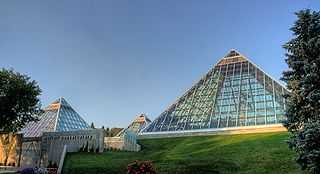
The Muttart Conservatory is a botanical garden located in the North Saskatchewan river valley, across from the downtown core in Edmonton, Alberta, Canada. One of the best-known landmarks of Edmonton, the conservatory consists of three city-operated greenhouses, public gardens, as well as four feature pyramids for display of plant species found across three biomes, with the fourth pyramid hosting a seasonal display. A fifth minor skylight pyramid lights up the central foyer.

The Meadows is a residential district in the City of Edmonton, Alberta, Canada. Located in southeast Edmonton, The Meadows is bounded by Whitemud Drive to the north, 34 Street to the west, and Anthony Henday Drive to the east and south. The residential district of Mill Woods is immediately west of The Meadows across 34 Street, while Strathcona County is located to the east across Anthony Henday Drive.
David B. Williams is a noted Canadian Ojibway aboriginal artist.

The Universal Day of Culture under the Banner of Peace, known also as the World Day of Culture, is an observance held annually on April 15 in many countries around the World to promote the protection of culture, the Roerich Pact and the Banner of Peace.
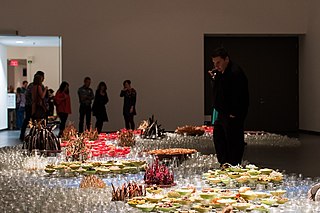
Lyndal Osborne is a Canadian artist based in Edmonton, Alberta. She was born in Newcastle, New South Wales, Australia. Her works include BioArt, Sculpture, Video art, and multimedia. Osborne's' installation work speaks of the forces of transformation within nature and provides a commentary on issues relating to the environment. In her more recent works, Osborne has also examined the issues of genetically modified organisms as subject matter.

Mary Annora Brown (1899–1987), known as Annora Brown, was a Canadian visual artist whose work encompassed painting and graphic design. She was best known for her depictions of natural landscapes, wildflowers, and First Nations communities in Canada. Much of her work thematically explored Albertan identity, though she remains relatively obscure in discussions of Canadian art.
Jenny Margetts, born Jane Maria Shirt, was an Indigenous woman who advocated for women and children. She was born to Felix and Louisa Doghead Shirt on the Saddle Lake Reserve in Alberta, Canada. Growing up in a family of ten, she attended Blue Quills Indian Residential School for nine years. Following graduation from Victoria Composite High School in Edmonton, Alberta. she decided to enter the Dominican Order. Jenny traveled with Bishop Lussier by train and arrived in Quebec City, Quebec on April 22, 1954. After six months as a postulant she became a novice and chose the name Louisa in honor of her mother. Sister Louisa spent the next two years in religious formation, learning French. Shortly after taking her First Vows returned to Saddle Lake to work in a newly established mission. She told of having a dream of a man crying, and her phoning home to Saddle Lake, and being told, “Come back. You do not belong there. We need you here.” During this period, she decided the religious life was not for her, and left the Order in June 1957. She remembered taking a social justice course from a priest who told her that even one person who is concerned can make changes. Three years later she married, started a family, and became an activist for Indigenous women and children.
References
- 1 2 3 12th Annual Mother Language Book. Edmonton: IHLA, 2015. P. 219
- ↑ Alberta Education Private Schools Archived 2012-04-20 at the Wayback Machine . EIS1007P. February 15, 2012.
- 1 2 Koleso (Alberta bi-weekly Russian newspaper) Archived 2015-02-23 at the Wayback Machine . March 22nd, 2012.
- ↑ The InterScience Cup
- ↑ Amoryn Engel. Golden moments in Alberta. National Post. Saturday, April 21, 2012.
- ↑ Johann Strauss Ball 2011. The Interscience Cup, February 13th, 2011.
- 1 2 Lillian Osborne High School School Council Meeting Minutes Archived 2015-05-18 at the Wayback Machine . December 6th, 2012.
- ↑ The perfect day for planting. The Interscience Cup, June 9th, 2010.
- ↑ Have fun with growing native plants. The Interscience Cup, June 2nd, 2010
- ↑ Interscience Summer Camp. The Interscience Cup, August 2nd, 2008.
- ↑ Virtual Museum of Nikolay Zelinsky. The InterScience Cup. June 16, 2014.
- ↑ Russian Folk Costume. The Interscience Cup, May 20th, 2012.
- ↑ Armenian National Costumes. The Interscience Cup, April 27th, 2012.
- ↑ Mosaic. Canadian Russian News. October 2010
- ↑ Thanks Shohei for great movie!!! The InterScience Cup, June 2010.
- 1 2 "Between Alex and Sasha" - official site of the documentary.
- ↑ Claire Theobald. International Mother Language Day declared in Edmonton. Edmonton Sun, February 21, 2015.
- ↑ Отбелязване на Световния ден на културата в гр. Едмънтън, Канада (Celebration of the Universal Day of Culture in Edmonton, Canada) Palitra, IV-2012/I-2013 (48-49). ISSN 1314-5002.
- ↑ International Week for a Better World Archived 2015-02-23 at the Wayback Machine . University of Alberta Global Education Program, 2015.
- ↑ ESL and Computer Literacy in the West End of Edmonton
- ↑ "ECALA members". Archived from the original on 2015-02-23. Retrieved 2015-02-23.